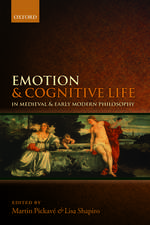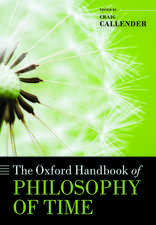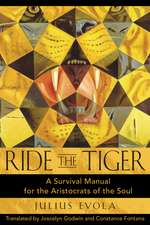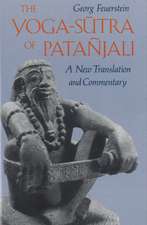Shiva: The Wild God of Power and Ecstasy
Autor Wolf-Dieter Storl Ph.D.en Limba Engleză Paperback – 13 sep 2004
Preț: 135.85 lei
Nou
Puncte Express: 204
Preț estimativ în valută:
25.100€ • 27.49$ • 21.69£
25.100€ • 27.49$ • 21.69£
Carte disponibilă
Livrare economică 09-23 decembrie
Preluare comenzi: 021 569.72.76
Specificații
ISBN-13: 9781594770142
ISBN-10: 159477014X
Pagini: 312
Ilustrații: 166 b&w illustrations
Dimensiuni: 152 x 229 x 18 mm
Greutate: 0.5 kg
Editura: Inner Traditions/Bear & Company
Colecția Inner Traditions
Locul publicării:United States
ISBN-10: 159477014X
Pagini: 312
Ilustrații: 166 b&w illustrations
Dimensiuni: 152 x 229 x 18 mm
Greutate: 0.5 kg
Editura: Inner Traditions/Bear & Company
Colecția Inner Traditions
Locul publicării:United States
Notă biografică
Wolf-Dieter Storl, Ph.D., is a cultural anthropologist and ethnobotanist who has taught at Kent State University as well as in Vienna, Berne, and Benares. He is coauthor of Witchcraft Medicine and has written a number of books on indigenous culture and ethnobotany. He lives in Allgäu, Germany.
Extras
Chapter 6
The Dancer in the Flames
This is my greatest desire: without fail,
one day you’ll show yourself to us,
My father with locks twisted like the flames
of a lighted fire
the place where you dance, in full night,
over the high flames . . .
Arputa Tiruvantati, fourteenth century Tamil poetess
Let us visit once again the hidden pine forest, where honorable hermits and their chaste wives are meditating and practicing asceticism, and see how Shiva makes fools of them. In this version of the story, there are not just seven rishis but tens of thousands. They have shaven their heads in penance; they despise all mundane joys and passions. Unremittingly, they preach to the common people that the universe is infinite having no beginning and no end and that there is no God who saves souls, but that each must work diligently on one’s own salvation. (The suspicion rises that this story tells of the struggle of emerging Hinduism with the dogmas of the Buddhists and Jains.)
Gracious Shiva, seeing the damage these fanatics were doing, decided to free them of their delusions. Using the power of his magical illusion, he stepped into their world as a most handsome young yogi. Vishnu was with him in the form of a beguiling Mohini, a heavenly nymph. At the sight of the young Adonis, the rishis’ wives were dazzled. Forgetting their duties, like silly girls, they daydreamed of being caressed by his strong, white arms and kissed by his full lips. They let the water jugs slide from their hands and break; they let the food scorch in the pans.
Their husband made fools of themselves likewise. Unthinkingly, they threw away the fruits of thousands of years of hardest penance in order to feast their longing eyes on the voluptuous curves of the heavenly maiden. But then, they suddenly regained their senses and were terrified to realize that their resolves had so weakened. Their shock quickly turned into hateful anger, which consumed the rest of the fruits of their asceticism. They meanly rebuked their wives and began to hurl the vilest curses at the handsome yogi and his seductive female companion. Combining their magic powers, they ignited a fire into which they chanted mantras of death and destruction. On and on they chanted, fanning the flame into the form of a monstrous, murderous tiger. This they directed to tear the strange, naked interloper to pieces. But the yogi skinned it with the nail of his little finger. Next, the hermits let a gigantic poisonous viper rise from the magic fire; but Shiva wrapped it around his neck as though it were a silk shawl. Seeing their efforts fail, the furious ascetics combined all their remaining strength to conjure the most terrible weapon of which they could conceive. It was a wicked, black, misshapen dwarf with an invincible club. But as soon as he leaped out of the flames, Shiva bowled him over and began to dance light-footedly on the squat torso, taking on his divine emanation as Nataraja, the king of dancers, revealing himself as the lord of the universe and of eternity.
At this, the poor rishis fell to the ground, trembling with fear, while all the gods of the universe appeared to behold the wonder of the dancing god. The world serpent Anant-Shesha, on whose back Vishnu sleeps in the intervals between creations, was so enthralled by the splendor of the spectacle, that he asked Vishnu for leave. His reptilian heart was filled with only one wish, and that was to be allowed to go on a pilgrimage to Mount Kailash. There, he wanted to engage in severe penance so that he might find out the meaning of this overawing cosmic dance.
Thus it happened that the thousand-headed, jewel-crowned primordial serpent spent eons in single-minded devotion. Nothing distracted him, until one day, Shiva, appearing as Brahma riding on the gander, told him, “Your devotion is perfect! I shall reward you with eternal paradise!”
But the snake refused paradise. Instead, it wanted to be allowed to continue watching Shiva’s dance forever. At this, Shiva took on his own radiant form and taught Ananta the essence of wisdom, which are the Vedas, and promised him, “You will shed your serpentine form and you will be born of a human couple. When you are old enough to leave your parent’s home, your footsteps will lead you to Chidambaram. There, in the shade of a hallowed grove, you shall find my lingam, which is cared for by an old meditant. You may help him in his duties, for here, at the Chidambaram Lingam, I reveal my eternal cosmic dance to all who have eyes to see.”
Ever since, Chidambaram, a town on the coast south of Pondicherry, is a much-visited place of pilgrimage. It was here that the now world-famous bronze casting of Shiva-Nataraja, dancing in a ring of fire, originated.
Let us now look at this dancing god. . . . Like Shankar, his face is calm and collected, and cobras and rudraksha beads decorate his limbs. But otherwise, he is in total motion, his hair swirling wildly around his head. Ganga is no longer visible as a jet of water, but as a tiny, hard-to-see female figure, riding the waves of his hair. The hand drum (damaru) no longer hangs silent on the trident, but vibrates energetically in his upper right hand. Every one of his four hands is flashing a special gesture, or mudra, expressing esoteric meaning. The upper left hand, held cupped like a half moon (ardhachandra mudra), contains a blazing fire. A third arm, bent like the trunk of an elephant (gajahasta mudra), reminds the worshipper of Ganesha, the clever bull elephant who overcomes all resistance. It points down toward the uplifted left foot, indicating cosmic lightness and nonattachment. The fourth hand stretches its open palm toward the beholder in the abhaya gesture, signaling, “Fear not! May peace be with you!”
The Dancer in the Flames
This is my greatest desire: without fail,
one day you’ll show yourself to us,
My father with locks twisted like the flames
of a lighted fire
the place where you dance, in full night,
over the high flames . . .
Arputa Tiruvantati, fourteenth century Tamil poetess
Let us visit once again the hidden pine forest, where honorable hermits and their chaste wives are meditating and practicing asceticism, and see how Shiva makes fools of them. In this version of the story, there are not just seven rishis but tens of thousands. They have shaven their heads in penance; they despise all mundane joys and passions. Unremittingly, they preach to the common people that the universe is infinite having no beginning and no end and that there is no God who saves souls, but that each must work diligently on one’s own salvation. (The suspicion rises that this story tells of the struggle of emerging Hinduism with the dogmas of the Buddhists and Jains.)
Gracious Shiva, seeing the damage these fanatics were doing, decided to free them of their delusions. Using the power of his magical illusion, he stepped into their world as a most handsome young yogi. Vishnu was with him in the form of a beguiling Mohini, a heavenly nymph. At the sight of the young Adonis, the rishis’ wives were dazzled. Forgetting their duties, like silly girls, they daydreamed of being caressed by his strong, white arms and kissed by his full lips. They let the water jugs slide from their hands and break; they let the food scorch in the pans.
Their husband made fools of themselves likewise. Unthinkingly, they threw away the fruits of thousands of years of hardest penance in order to feast their longing eyes on the voluptuous curves of the heavenly maiden. But then, they suddenly regained their senses and were terrified to realize that their resolves had so weakened. Their shock quickly turned into hateful anger, which consumed the rest of the fruits of their asceticism. They meanly rebuked their wives and began to hurl the vilest curses at the handsome yogi and his seductive female companion. Combining their magic powers, they ignited a fire into which they chanted mantras of death and destruction. On and on they chanted, fanning the flame into the form of a monstrous, murderous tiger. This they directed to tear the strange, naked interloper to pieces. But the yogi skinned it with the nail of his little finger. Next, the hermits let a gigantic poisonous viper rise from the magic fire; but Shiva wrapped it around his neck as though it were a silk shawl. Seeing their efforts fail, the furious ascetics combined all their remaining strength to conjure the most terrible weapon of which they could conceive. It was a wicked, black, misshapen dwarf with an invincible club. But as soon as he leaped out of the flames, Shiva bowled him over and began to dance light-footedly on the squat torso, taking on his divine emanation as Nataraja, the king of dancers, revealing himself as the lord of the universe and of eternity.
At this, the poor rishis fell to the ground, trembling with fear, while all the gods of the universe appeared to behold the wonder of the dancing god. The world serpent Anant-Shesha, on whose back Vishnu sleeps in the intervals between creations, was so enthralled by the splendor of the spectacle, that he asked Vishnu for leave. His reptilian heart was filled with only one wish, and that was to be allowed to go on a pilgrimage to Mount Kailash. There, he wanted to engage in severe penance so that he might find out the meaning of this overawing cosmic dance.
Thus it happened that the thousand-headed, jewel-crowned primordial serpent spent eons in single-minded devotion. Nothing distracted him, until one day, Shiva, appearing as Brahma riding on the gander, told him, “Your devotion is perfect! I shall reward you with eternal paradise!”
But the snake refused paradise. Instead, it wanted to be allowed to continue watching Shiva’s dance forever. At this, Shiva took on his own radiant form and taught Ananta the essence of wisdom, which are the Vedas, and promised him, “You will shed your serpentine form and you will be born of a human couple. When you are old enough to leave your parent’s home, your footsteps will lead you to Chidambaram. There, in the shade of a hallowed grove, you shall find my lingam, which is cared for by an old meditant. You may help him in his duties, for here, at the Chidambaram Lingam, I reveal my eternal cosmic dance to all who have eyes to see.”
Ever since, Chidambaram, a town on the coast south of Pondicherry, is a much-visited place of pilgrimage. It was here that the now world-famous bronze casting of Shiva-Nataraja, dancing in a ring of fire, originated.
Let us now look at this dancing god. . . . Like Shankar, his face is calm and collected, and cobras and rudraksha beads decorate his limbs. But otherwise, he is in total motion, his hair swirling wildly around his head. Ganga is no longer visible as a jet of water, but as a tiny, hard-to-see female figure, riding the waves of his hair. The hand drum (damaru) no longer hangs silent on the trident, but vibrates energetically in his upper right hand. Every one of his four hands is flashing a special gesture, or mudra, expressing esoteric meaning. The upper left hand, held cupped like a half moon (ardhachandra mudra), contains a blazing fire. A third arm, bent like the trunk of an elephant (gajahasta mudra), reminds the worshipper of Ganesha, the clever bull elephant who overcomes all resistance. It points down toward the uplifted left foot, indicating cosmic lightness and nonattachment. The fourth hand stretches its open palm toward the beholder in the abhaya gesture, signaling, “Fear not! May peace be with you!”
Cuprins
Introduction
Chapter 1--Journey to the Source of Time
Chapter 2--Fire and Ice
The Rock
Water
Kashi
Karttikeya’s Strange Birth
Chapter 3--The Shaman and His Black Dog
The Old Huntsman
Pashupati, Lord of the Animals
The Noose
The Black Dog
The God of the Shades
Bhairava
Rudra and Odin-
The Treacherous God
Chapter 4--God’s Virile Member
Lingam Yoni
The Lingam Is Everywhere
How Arjuna Won His Magic Arrows
How Markandeya Became an Immortal
The Phallic Symbol
The Pillar of Fire
Chapter 5--Shankar, The Yogi on the Mountain
Shankara
The Tears of Rudra
The God Clothed in Air
The Third Eye
Three Lines of Ash
The Blue Neck
Shiva and Buddha
The Trident and the”Bâton-de-Commandement”
Chapter 6--The Goddess
Devi
Durga
Kali
Annapurna
Ganga
Chapter 7--The Dancer in the Flames
Shiva’s Dances
The Drum
Chapter 8--The Ideal Family
Karttikeya
Ganesha
Nandi the Bull
Chapter 9--The Destruction of the Sacrifice
The Aryan Background
Daksha’s Great Sacrifice
Shiva the Sinner
Chapter 10--Shiva as the Devil
Zarathustra
The Earth Runs Well
The Righteous Battle
Chapter 11--Tantra: The Serpent’s Path
The Heresy of the Agamas
Overcoming the Ego
Shakti
The Pathway of the Kundalini Serpent
Returning to Oneness
Chapter 12--The Saint, the Hero, and the Beast
The Rituals
Tantric Influence
Chapter 13--Pollen Dust and Ashes
Lingam Puja
Shiva’s Flower Garden
Bel: Shiva’s Triune Leaf
Bangeri Baba
Shiva’s Garden of Madness
Sacred Ashes
The Shadow of the Night
Chapter 14--Shiva’s Festivals and Holidays
The Descent of the Goddess
Festivals of the Hot Season and the Rainy Season
Festivals of the Fall Season
Festivals of Spring
Kumbha Mela
Notes
Bibliography
Index
Chapter 1--Journey to the Source of Time
Chapter 2--Fire and Ice
The Rock
Water
Kashi
Karttikeya’s Strange Birth
Chapter 3--The Shaman and His Black Dog
The Old Huntsman
Pashupati, Lord of the Animals
The Noose
The Black Dog
The God of the Shades
Bhairava
Rudra and Odin-
The Treacherous God
Chapter 4--God’s Virile Member
Lingam Yoni
The Lingam Is Everywhere
How Arjuna Won His Magic Arrows
How Markandeya Became an Immortal
The Phallic Symbol
The Pillar of Fire
Chapter 5--Shankar, The Yogi on the Mountain
Shankara
The Tears of Rudra
The God Clothed in Air
The Third Eye
Three Lines of Ash
The Blue Neck
Shiva and Buddha
The Trident and the”Bâton-de-Commandement”
Chapter 6--The Goddess
Devi
Durga
Kali
Annapurna
Ganga
Chapter 7--The Dancer in the Flames
Shiva’s Dances
The Drum
Chapter 8--The Ideal Family
Karttikeya
Ganesha
Nandi the Bull
Chapter 9--The Destruction of the Sacrifice
The Aryan Background
Daksha’s Great Sacrifice
Shiva the Sinner
Chapter 10--Shiva as the Devil
Zarathustra
The Earth Runs Well
The Righteous Battle
Chapter 11--Tantra: The Serpent’s Path
The Heresy of the Agamas
Overcoming the Ego
Shakti
The Pathway of the Kundalini Serpent
Returning to Oneness
Chapter 12--The Saint, the Hero, and the Beast
The Rituals
Tantric Influence
Chapter 13--Pollen Dust and Ashes
Lingam Puja
Shiva’s Flower Garden
Bel: Shiva’s Triune Leaf
Bangeri Baba
Shiva’s Garden of Madness
Sacred Ashes
The Shadow of the Night
Chapter 14--Shiva’s Festivals and Holidays
The Descent of the Goddess
Festivals of the Hot Season and the Rainy Season
Festivals of the Fall Season
Festivals of Spring
Kumbha Mela
Notes
Bibliography
Index
Recenzii
“An intimate portrait of Shiva, that most complex of Hindu Gods. Reading this book is like finding an oasis in the desert of monotheism.”
“Discusses the roots and the manifestations of Shiva, the original mystic, and his relevance to modern life in both the East and the West. This book will amuse, shock, and, most important, provoke readers to think about their own cherished conceptions of the world.”
“An encyclopedic and highly inspiring account of Shiva.”
"This thorough, academic book will interest students of comparative religions, Eastern philosophies."
“In Shiva, Storl creates a vibrant and comprehensive portrait of this omnipresent wild god.”
“Wolf-Dieter Storl expertly traces the history of the lore of Shiva through the influences of invading cultures and religions, and relates a wide variety of seemingly diverse influences to Shiva’s story such as the Celtic Christian legend of the Holy Grail. As engaging and entertaining as he is informational, Storl opens the reader’s eyes to Hindu culture and religion as though one is a tourist traveling the land for the first time.”
“Discusses the roots and the manifestations of Shiva, the original mystic, and his relevance to modern life in both the East and the West. This book will amuse, shock, and, most important, provoke readers to think about their own cherished conceptions of the world.”
“An encyclopedic and highly inspiring account of Shiva.”
"This thorough, academic book will interest students of comparative religions, Eastern philosophies."
“In Shiva, Storl creates a vibrant and comprehensive portrait of this omnipresent wild god.”
“Wolf-Dieter Storl expertly traces the history of the lore of Shiva through the influences of invading cultures and religions, and relates a wide variety of seemingly diverse influences to Shiva’s story such as the Celtic Christian legend of the Holy Grail. As engaging and entertaining as he is informational, Storl opens the reader’s eyes to Hindu culture and religion as though one is a tourist traveling the land for the first time.”
Descriere
An extensive look at all the aspects of multi-natured Shiva.

















